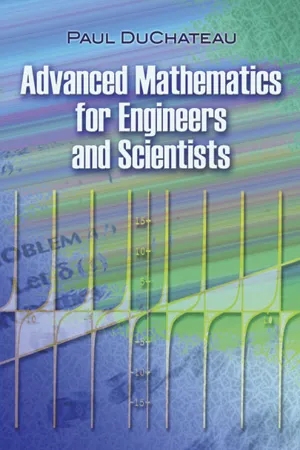Technology & Engineering
Nonlinear Differential Equation
A nonlinear differential equation is a type of differential equation that cannot be expressed in a linear form. It involves nonlinear terms, making it more complex to solve compared to linear differential equations. Nonlinear differential equations are commonly encountered in various fields such as physics, engineering, and biology, and often require numerical methods for approximation.
Written by Perlego with AI-assistance
Related key terms
Related key terms
1 of 4
Related key terms
1 of 3
3 Key excerpts on "Nonlinear Differential Equation"
- Paul DuChateau(Author)
- 2013(Publication Date)
- Dover Publications(Publisher)
5Nonlinear Ordinary Differential Equations
I n the previous chapter we saw that the general solution to a linear differential equation of order n (or an n × n system of first order equations) contains n arbitrary constants of integration. Each choice of values for these constants produces a particular solution to the equation and every solution corresponds to some choice of values for the constants. The situation for nonlinear equations is less simple. Even for those special nonlinear equations where it is possible to construct solutions containing arbitrary constants, it may happen that there exist other solutions to the equation that correspond to no value of the constants. In general it is not even possible to find closed form solutions for Nonlinear Differential Equations in terms of elementary functions. For that reason we will often have to be content with deducing qualitative properties of the solution from observations about the equation or system of equations.It is often possible, for examples, to determine the ultimate behavior of a nonlinear system without knowing precisely how the system evolves. This is the question of asymptotic stability. Similarly we may be able to determine if periodic solutions to a system exist without being able to construct such a solution exactly. Some simple tools for considering such questions are presented in this chapter:For nonlinear equations where the exact solution cannot be found and a qualitative description of the solution is insufficient, we may construct an approximate solution by numerical methods. Numerical solutions are discussed in Chapter 12 and have been used here to construct the figures in the solved problems which relate to Nonlinear systems.NONLINEAR EQUATIONS
The most general differential equation of order n in the unknown function y(t) and independent variable t is of the form F(t, y, y’, . . . , y (n) ) = 0. In general this equation has no solution expressible in terms of elementary functions, even in the case n- eBook - ePub
- Clayton R. Paul(Author)
- 2011(Publication Date)
- Wiley-IEEE Press(Publisher)
y(x). You should be alert to this throughout your engineering studies. It is embarrassing not to know how to solve the differential equationonce you have learned to solve the differential equationas there are no differences in their solutions. We will consider only first- and second-order differential equations, meaning that the highest-order derivative will be first or second, respectively. Although higher-order differential equations occur frequently in engineering systems, they are only slightly more tedious to solve. However, you can easily extend to higher-order differential equations the methods we develop for first- and second-order equations.The equation is said to be linear if neither x(t) nor its derivatives are raised to a power greater than 1, and no products of x(t) and its derivatives appear. Note that there is a significant difference betweend2 x(t)/dt2and[dx(t)/dt]2 :The first is a second-order derivative and the second is a first-order derivative that is squared. An example of a nonlinear differential equation isThe equation is constant-coefficient if a and b are constants that are not functions of t. An example of a non-constant-coefficient differential equationIf a differential equation is either (a) non-constant-coefficient and/or (b) nonlinear, it is extremely difficult to solve, and generally only numerical, approximate solutions are obtainable! As was the case with algebraic equations, nonlinear and/or time-varying (nonconstant coefficient) differential equationsoccur throughout all of the engineering disciplines. But because they are so difficult to solve that an attempt at hand solution yields little or no insight into how a system behaves, we generally resort to solving them numerically in an approximate fashion using a computer or a calculator. Numerical solutions of differential equations are discussed at the end of this chapter. Throughout all of this you should keep in mind that the primary goal is to use mathematical skills to determine what the equations governing the system are telling us about how the system behaves. - Kam Tim Chau(Author)
- 2017(Publication Date)
- CRC Press(Publisher)
Whether the differential equation is linear or nonlinear, it all depends on the nonlinearity of u and has nothing to do with the coefcient functions a 1,…, a n, which are not functions of the unknown u. All terms of u or its derivatives appear in (2.6) in their first order or first degree. In general if a differential equation is not linear, it is nonlinear. However, in more advanced books dealing with Nonlinear Differential Equations, there are two kinds of nonlinearity: (i) quasi-linear differential equations, in which nonlinearity of u appears in the coefficient functions in a 1 a n in (2.6); and (ii) nonlinear equations in which nonlinearity occurs in the highest order derivative term (Kevorkian and Cole, 1981). Clearly, the first kind of nonlinearity is called quasi-linear because its solution technique is simpler than those for the second type ofnonlinearity. For example, the following second order partial differential equation is quasi- linear because there is no nonlinearity in its highest derivative (second. order): (2.7) A 11 (x 1, x 2, u, ∂ u ∂ x 1, ∂ u ∂ x 2) ∂ 2 u ∂ x 1 2 + A 12 (x 1, x 2, u, ∂ u ∂ x 1, ∂ u ∂ x 2) ∂ 2 u ∂ x 1 ∂ x 2 + A 22 (x 1, x 2, u, ∂ u ∂ x 1,. ∂ u ∂ x 2) ∂ 2 u ∂ x 2 2 = F (x 1, x 2, u ∂ u ∂ x 1, ∂ u ∂ x 2) For first order partial differential equations, the following form is. quasi-linear (2.8) A 1 (x 1, x 2, u) ∂ u ∂ x 1 + A 2 (x 1, x 2, u) ∂ u ∂ x 2 = B (x 1, x 2, u) Most ofthe established methods of solutions for differential equations are for linear ODEs or PDEs. Indeed, most of the differential equations to be discussed in this book are linear. Although some methods for solving Nonlinear Differential Equations approximately have been developed (such as the perturbation method to be discussed in Chapter 12), in general there are no well-accepted methods to deal with Nonlinear Differential Equations. Quite often we have to rely on numerical methods to get approximate solutions for Nonlinear Differential Equations
Index pages curate the most relevant extracts from our library of academic textbooks. They’ve been created using an in-house natural language model (NLM), each adding context and meaning to key research topics.
Explore more topic indexes
Explore more topic indexes
1 of 6
Explore more topic indexes
1 of 4


